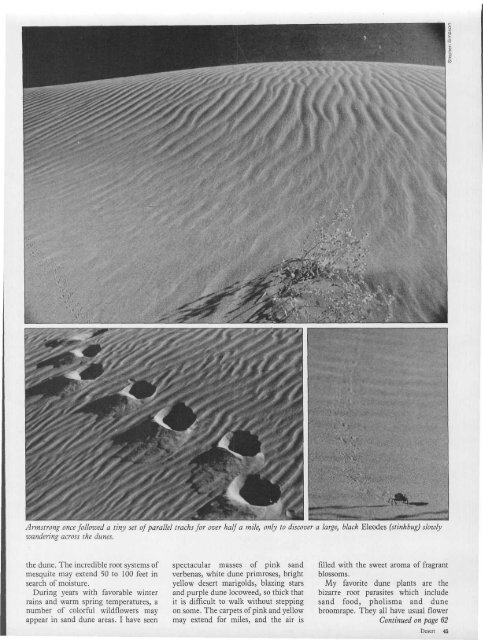fea I >. • - Desert Magazine of the Southwest
fea I >. • - Desert Magazine of the Southwest
fea I >. • - Desert Magazine of the Southwest
You also want an ePaper? Increase the reach of your titles
YUMPU automatically turns print PDFs into web optimized ePapers that Google loves.
ffii<br />
Armstrong once followed a tiny set <strong>of</strong> parallel tracks for over half a mile, only to discover a large, black Eleodes (stinkbug) slowly<br />
wandering across <strong>the</strong> dunes.<br />
<strong>the</strong> dune. The incredible root systems <strong>of</strong><br />
mesquite may extend 50 to 100 feet in<br />
search <strong>of</strong> moisture.<br />
During years with favorable winter<br />
rains and warm spring temperatures, a<br />
number <strong>of</strong> colorful wildflowers may<br />
appear in sand dune areas. I have seen<br />
spectacular masses <strong>of</strong> pink sand<br />
verbenas, white dune primroses, bright<br />
yellow desert marigolds, blazing stars<br />
and purple dune locoweed, so thick that<br />
it is difficult to walk without stepping<br />
on some. The carpets <strong>of</strong> pink and yellow<br />
may extend for miles, and <strong>the</strong> air is<br />
filled with <strong>the</strong> sweet aroma <strong>of</strong> fragrant<br />
blossoms.<br />
My favorite dune plants are <strong>the</strong><br />
bizarre root parasites which include<br />
sand food, pholisma and dune<br />
broomrape. They all have usual flower<br />
Continued on page 62<br />
<strong>Desert</strong> 45

















